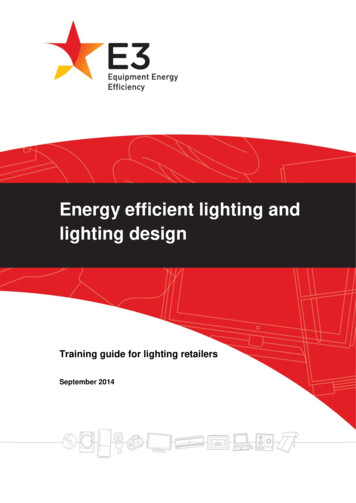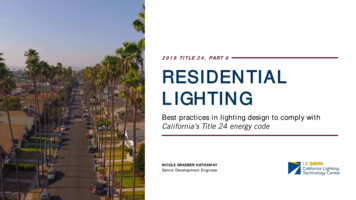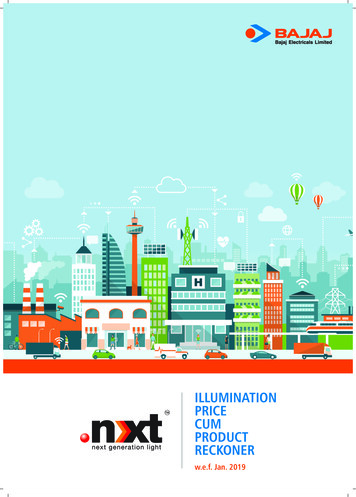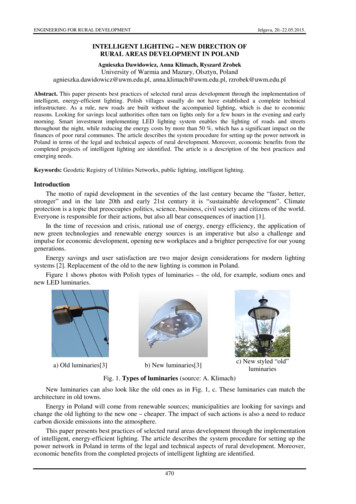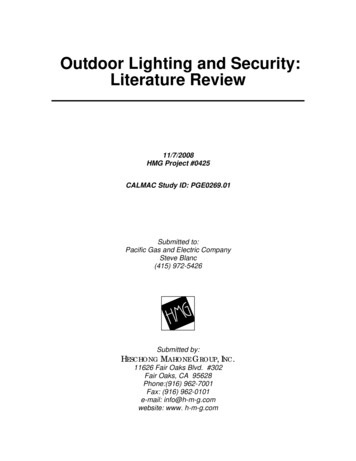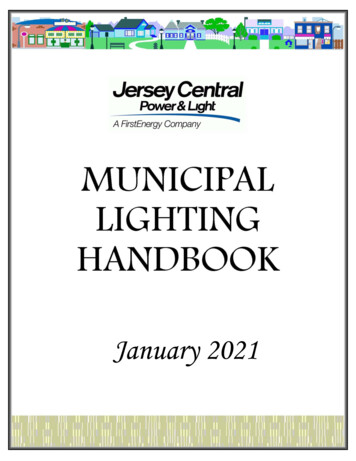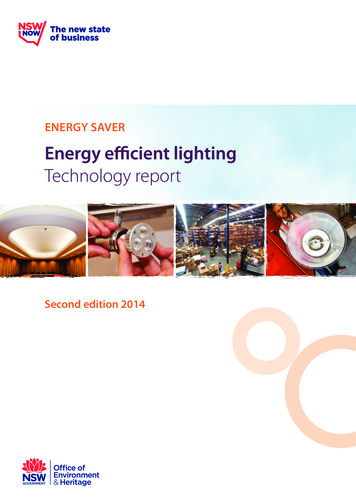
Transcription
ENERGY SAVEREnergy efficient lightingTechnology reportSecond edition 2014
Published by:Office of Environment and HeritageDepartment of Premier and Cabinet59-61 Goulburn Street, SydneyAustraliaPh: 02 9995 5000 (switchboard)Ph: 131 555 (environment information and publication requests)Ph: 1300 361 967 (national parks, climate change and energyefficiency information and publication requests)Fax: 02 9995 5999TTY: 02 9211 4723Email: info@environment.nsw.gov.auWebsite: www.environment.nsw.gov.auOEH 2014/0017ISBN 978 174293 646 8First published July 2012Second edition 2014 Copyright State of NSW and the Office of Environment and Heritage 2014The Office of Environment and Heritage and the State of NSW are pleased to allow this material tobe reproduced in whole or in part for educational and non-commercial use, provided the meaning isunchanged and its source, publisher andauthorship are acknowledged.The Office of Environment and Heritage has compiled the Energy efficient lighting technology reportin good faith, exercising all due care and attention. Office of Environment and Heritage OEH doesnot accept responsibility for any inaccurate or incomplete information supplied by third parties. Norepresentation is made about the accuracy, completeness or suitability of the information in thispublication for any particular purpose. OEH shall not be liable for any damage which may occur toany person or organisation taking action or not on the basis of this publication. Readers should seekappropriate advice when applying the information to their specific needs.This report was prepared on behalf of the Office of Environment and Heritage by Julien Freed Consulting,and is based on calculations completed in early 2014. Savings estimated in the report do not cover theadditional benefits that may be achieved by a reduction in air conditioning use.
Table of contentsOverview. 3How to use this report . 3SUMMARY OF LIGHTING UPGRADE OPTIONS. . 4Introduction. 6Energy and cost savings. . . 6General lighting information. . . 7Light emitting diodes (LED) – an emerging technology?. 12Upgrading lighting – factors to consider. 15Efficient lighting best practice. . . 16Developing a business case for upgradingto energy efficient lighting. 17Lamp disposal and recycling. 20Energy Savings Certificates . 20Energy efficient lighting upgrades – options. 231. Interior lighting. 23LINEAR FLUORESCENT LUMINAIRES. 24Twin 36 W T8 recessed linear fluorescent luminaires. . 24Twin 36 W T8 surface mounted linear fluorescent luminaires. 38HALOGEN LAMPS. 5050 W MR16 low voltage dichroic halogen lamps . 50Parabolic aluminised reflector (PAR) lamps and other halogen downlights. . . 632. High and low bay lighting . 67400 W mercury vapour luminaires . . 68400 W metal halide luminaires. 783. Exterior lighting. 85HALOGEN FLOODLIGHTING . 86500 W linear lamp shovel and box floodlights. . . 86Metal halide floodlighting. 90Road lighting. 914. Emergency and exit lighting. 94Recessed downlights . 94Fluorescent battens . 94Exit signs . . . 955. Lighting controls. 96Upgrading basic switches to coded switch banks for manual zone switching. . 97Occupancy sensing . 97Building management system (BMS) goals and commissioning control systems . 98Voltage reduction and voltage optimisation. 99Contents1
Appendix 1: General lighting information. 100Common types of lights. 100Overall efficiency of light sources. 105Appendix 2: Measurement and verification (M&V). 106Glossary . 107Abbreviations and acronyms. 109Table of figures. . 110Index. 112Preface to the Second editionWith the rapid advancement of lighting technology and continuing decreases in productprices, OEH has updated the Energy efficient lighting technology report published in July 2012.This is not a major revision but focuses on the addition of improved business cases for lightingupgrade options. In particular: New LED options for upgrading twin 36W T8 linear fluorescent luminaires, 50W MR16 lowvoltage dichroic halogen lamps and 500W linear lamp shovel and box floodlights Inclusion of options for replacement of twin 36 W T8 surface mounted recessedfluorescent luminaires Preferred LED options for upgrading 400W mercury vapour luminaires and 400W metalhalide high bay luminaires Updated costs for all upgrade options for 400W mercury vapour luminairesThis second edition also provides an overview of the proposed changes to the Energy SavingScheme (ESS) Rule. The ESS rule outlines how to calculate the number of eligible EnergySaving Certificates which can reduce the cost of a lighting upgrade. (p. 20)2ENERGY SAVER Energy efficient lighting technology report
OverviewLighting contributes significantly to business energy use and operating costs.Increasing energy prices highlight the need to reduce the cost of lighting.Energy use associated with lighting systems can be reduced by up to82 per cent if energy efficient lighting practices are adopted.Efficient lighting systems not only reduce energyconsumption but improve the working environment, increasesafety and enhance staff well-being.2. link artificial light use to the natural light levels (daylightlinking) using sensors and smart control systems tominimise energy useThis report is designed to help you identify appropriate andreliable energy efficient lighting technology that would besuitable for your facility. The report addresses:3. assess options for de-lamping, dimming or multilevelswitching to reduce energy consumption general information – measuring light, common typesof lighting, light emitting diodes (LED) as an emergingtechnology, lamp disposal and recycling and developinga business case (p. 7) interior lighting – upgrade options for lighting incommon commercial, industrial and institutional facilities,such as offices, manufacturing plants, warehouses,schools, libraries and hospitals (p. 23)4. identify low activity areas and assess use of occupancysensors5. review zoning and increase the number of zones (ifappropriate) to allow lights to be turned off when areasare not used6. identify lights that could be upgraded with more energyefficient lighting7. ensure the energy efficient lighting that is selected meetsAustralian Standards. exterior and road lighting – upgrade options forfloodlighting as well as major and minor road lighting(p. 85)How to use this report emergency and exit lighting – energy reductionstrategies associated with emergency and exit lightingproducts (p. 94)This report is not intended to be read cover to cover, butshould be used as a reference guide for choosing the mostappropriate lighting upgrade for your space. lighting control – potential for saving energy withoccupancy sensors, daylight linking, central switching,zone resetting, manual switching, timers and voltagereduction (p. 96)The most commonly used interior and exterior lights aredescribed in the introduction, along with an overview ofthe factors to consider when upgrading lighting. For eachexisting light application the potential energy efficientupgrade options are discussed. voltage reduction and optimisation – energy savingtechnology, particularly in older sites where major lightinginfrastructure changes may be difficult (p. 99) energy efficient lighting technical details – technicalspecifications for each lighting upgrade option includingilluminance, maintenance, safety and backgroundcalculations (See the Energy efficient Lighting technologyreport – technical details. Available on the OEH website.) Energy Savings Certificates – calculating the numberof Energy Savings Certificates (ESC) and how to apply forthem (See p. 20 Developing a business case for details onenergy savings certificates).It is important to review the lighting operations of your facilityin a holistic manner. For best practice, follow these steps:1. assess the available natural light and potential forimprovement, introduce natural light into open spacessuch as warehouses (e.g. through skylights)OverviewFinding the lighting upgrade that appliesto youThis report is designed on the premise that the reader isaware of their current lighting system.Please review the table on the following page to selectwhich types of existing lights are relevant. This table outlinespotential upgrade options for that specific type of light,including a summary of the typical costs and energy savings.For those who are unsure as to their current systems pleaseread general lighting information (p. 7) and Appendix 1 (p. 100).The Energy efficient Lighting technology report – technical detailscontains additional information for each lighting optionincluding a technical specification, allowing you to make thecorrect requests to lighting suppliers.If you cannot find a particular light in the contents page ortable please refer to the index.3
4ENERGY SAVER Energy efficient lighting technology reportNew twin 28 W T5 fluorescent luminaireNew single 28 W T5 luminaireLinear LED replacement lamps, 2 x 19 WT8 to 28 W T5 conversion kitsNew 30W integrated LED luminaire23456100200 kits200 lamps100100100New twin 28 W T5 linear fluorescent luminaireNew complete single 28 W T5 linear fluorescent luminaireLinear LED lamps, 2 x 19 WT8 to 28 W T5 conversion kit23452110010035 W IRC halogen lamp with electronic transformer7 W LED replacement lamp100200 kits200 lamps10010010035 W IRC halogen lamp50 W MR16 low voltage dichroic halogen lamp (page 50)New 43 Watt LED luminaire, Integrated LED moduleand power supply, fitted with diffuser1Twin 36 W T8 surface mounted linear fluorescent luminaire (page 38)Retrofit single 36 W T8 reflector and electronic ballast kit1Twin 36 W T8 recessed linear fluorescent luminaire (page 24)Upgrade optionsQuantity 7222704355217223292Costreduction( 08,00013,00013,0008,50012,000Typicalcapital cost( 80013,52015,600780014,040Energysaving(kWh ical simplepay back(yr)Energy and cost savings associated with typical lighting 58.314.8GHGreduction(tCO2 p.a.)The options are assigned a colour according to which type of existing lighting system they are to replace. All pages with the corresponding colour tab are specific for that option.SUMMARY OF LIGHTING UPGRADE (%)
Summary of lighting upgrade options515 W compact fluorescent lamp replacementNew 13 W compact fluorescent luminaire45New 27 W LED luminaire (non-dimmable)New 2 x 18 W compact fluorescent (DALI dimmable)New 27 W LED luminaire (DALI dimmable)2344 x 54 W T5 fluorescent luminaireNew 110 W LED luminaire200 W induction luminaire234New 210W LED luminaireNew 300 W induction lamp luminaire23New 150 W metal halide luminaireNew 110 W LED luminaire12500 W linear lamp shovel and box floodlight (page 86)New 320 W pulse-start metal halide luminaire1400 W metal halide luminaires (page 78)New 250 W metal halide luminaire1400 W mercury vapour luminaires (page 68)New 35 W ceramic metal halide luminaire1PAR lamps and other halogen downlights (page 63)New 16 W LED luminaire3Upgrade 100Quantity 6490116504538865044723396235174086Costreduction( capital cost( rgysaving(kWh 2.0Typical simplepay back(yr)Energy and cost savings associated with typical lighting .520.017.013.813.813.5GHGreduction(tCO2 on(%)
IntroductionLighting upgrades can significantly reduce energy use.The Office of Environment and Heritage (OEH) hasproduced the Energy efficient lighting technology reportas part of the Energy Saver program. This programpromotes the use of energy efficient technology in NSW.Two key steps towards improving lighting technology include:1. identifying lights that can be upgraded2. preparing a business case for upgrading lights.This Energy efficient lighting technology report can guide you through both of thesesteps. Once a business case is developed, capital expenditure decisions become easierand a pathway to upgrading lights becomes clearer. An example of a business case isgiven on p. 18.Energy efficient upgrades for a range of lighting types are discussed and lightquality and risk management are also taken into account. Performance and safetyspecifications are included for each lighting upgrade option.The payback period for each upgrade is included, i.e. the number of years in which thecapital cost would be repaid. But when lighting is near the end of its life, the marginalcost of a high efficiency system compared with a standard system is more realistic,rather than the total cost. When equipment is at the end of its useful life, financialreturn calculations should be made against the capital cost difference of ‘like for like’ vsenergy efficient equipment.While the focus of the report is for existing buildings, the principles outlined in thisreport are also relevant for new buildings.Training workshops make it possible for you to apply the principles outlined in thisreport to the specifics of your energy efficient lighting upgrade. For more informationon training available and to register for the lighting training workshop, please go r/training.htmEnergy and cost savingsLighting upgrades can significantly reduce energy use (by up to 82 per cent). There aretwo general types of upgrades: a retrofit and an entire luminaire replacement.A retrofit changes only part of an existing luminaire system, such as lamp or controlgear. The other option is to replace the entire luminaire with a new luminaire. Thedecision will depend on a number of factors. Generally, retrofitting requires less upfrontcapital and can be easily installed, but installing a new luminaire is often more costeffective in buildings that contain older equipment. Full replacement can also beeconomical where improvements in technology have led to reductions in price (e.g.light emitting diodes (LED), p. 12)Compliance with regulations and standards is often more easily achieved with fullreplacement solutions. Due to the complexity of compliance with regulations, werecommend that a risk assessment is carried out for projects where retrofit upgradesare considered.6ENERGY SAVER Energy efficient lighting technology report
In either a retrofit or entire luminaire replacement project,this report assumes that a one for one swap from existingtechnology to the new technology will satisfy the projectneeds. This is not always possible. It is important to includethe impact of the changed number of luminaires in the totalcost of ownership calculations where necessary.Luminous fluxThe total light output(in all directions) of alight source.Unit: lumen (lm)Energy efficient lighting often has a significantly lower heatload than traditional lighting, which means that less energyis required to cool a space. Upgrading lighting can reducethe amount of energy used by heating, ventilation and airconditioning (HVAC) systems. These savings have not beenquantified within this report, but should nevertheless be seenas an additional benefit.Light intensityThe light output in aspecified direction.Unit: candela (cd)While this report provides indicative costs and savings oftypical lighting upgrades, calculating accurate energy savingsat your specific site will require a site-based assessment.IlluminanceAmount of light fallingonto a surface.The OEH website provides a “live” version of the total cost ofownership calculator used within this report. The live tool iscalled ‘Calculight’ and can be used to provide total cost ofownership calculations that take into account the variablesspecific to your site and proposed upgrades. The Calculighttool can be accessed via .aspx.The luminous flux perunit area.Lux lumens per square metreVisible surfaceGeneral lighting informationThere is no substitute for good lighting design, which focuseson light quality as well as light quantity. The environmentis lit for people so lighting should be both functional andattractive. Understanding some basic lighting concepts canhelp when designing energy efficient lighting solutions.Electric lightSurface brightness.Visible surfaceLightintensityIlluminated surfaceDepends on the visiblesurface area, and the lightreflected by the surfaceto the eye.Unit: candela per square metreFigure 1: Light measurementsElectric light is measured in the four basic ways it interactswith its environment (Figure 1):1. how much light did we start with? – the light producedby a light source (typically a lamp) is measured in lumens(lm) and is called luminous flux2. where is the light going? – if light is directed towards asurface, rather than scattered and uncontrolled, the lightlevel will be higher on the surface. This is called luminousflux or light intensity and is measured in candela (cd)3. how much light got there? – the light arriving at asurface is called illuminance and this is measured in lux.Illuminance does not take into account how the surfacewill respond to the light, only how much gets there4. how does the surface look once it has been lit? – awhite wall will reflect a lot of the light directed at it andwill effectively become a light source, while a black wallwill not reflect much light. The luminance of a surface ismeasured in candela per square metre (cd/m2).Lighting suppliers most commonly use lumens (lm) as thedefining characteristic of the light source. When selecting aluminaire we need to understand how much of the producedlight will enter the space and where it will land. WhenIntroductionColour rendering index and correlatedcolour temperatureLight sources can appear similar in colour but mayrender, or ‘show’ the surface colour quite differently.The accuracy can be measured by the colour renderingindex or CRI. CRI is typically expressed as a number,where 100 represents the most true to life colourrendering.The colour appearance of the light source is representedby the correlated colour temperature (CCT). This is oftenshown on lamps as colour temperature with a unit ofKelvin (K). The higher the CCT the ‘cooler’ or blue thelight is – 2500 K has a very warm or yellow appearancewhere as 4000 K is a cool blueish light. 4000 K iscommon in office areas.A fluorescent tube may have a colour temperature of3000 K and a CRI of 80. A tube may also be available witha colour temperature of 4000 K and also have a CRI of 80.These tubes will represent the colours in objects equallywell, but will appear different in colour.7
200NoonsunlightTungstenlampRelative energy150WhiteLEDBar 00700Wavelength (nanometres)Figure 2: Common sources of visible lightAM radioFM radioTelevisionRadarMicrowavesInfrared radiationUltraviolet radiationX-raysGamma-raysCosmic rays10 610 510 410 310 210 -1210-1310-1410-1510-1610-1710-18metres (m)750700650600visible radiation550500Light colourThe human eye is capable of seeing a range of colours in theelectromagnetic spectrum. This means that if a light sourceproduces enough light within this range, most people will beable to see it and perceive the colour.When light hits an object, some (or all) of the light is reflectedby it, while some is absorbed. The human eye will perceivea colour, depending on the characteristics of the lit object.For example, an object that appears red has absorbed thewavelengths of other colours and reflected those that are red.The appearance of an object can be affected by the electriclight source, as each light source can represent differentregions of the spectra (Figures 2 and 3).Common types of lighting450400nanometres (nm)Figure 3: The electromagnetic spectrum8comparing technologies, resist any encouragement fromsuppliers to focus only on lumens produced. Lighting designsoftware will take into account all areas of light performance.ENERGY SAVER Energy efficient lighting technology reportMost luminaires consist of a lamp, lampholder and controlgear. The luminaire will also have a means of getting asmuch light as possible to leave the luminaire and travel inthe required direction. This could involve reflectors, louvres,lenses or diffusers.There are thousands of different lamp holders, tens ofthousands of different luminaire types, and even more typesof lamps. Here are some of the typical lamps that are used incommercial applications.
Common types of lightsMore detailed descriptions can be found in Appendix 1General lighting service incandescent lamps (GLS lamps)GLS lamps are no longer available to purchase due to their poor efficiency.These lights have often been used in auditoriums and theatres wheredimming is needed. Few sites remain where large quantities of these lampsare installed.Halogen lampsHalogen lampHalogen lamps are also an incandescent lamp. Where most incandescentlamps contain a tungsten filament and some gasses (typically argon and/ornitrogen), the halogen lamps also contain iodine. This significantly prolongslamp life and allows the filament to burn hotter and therefore whiter. Halogenlamps are generally more efficient than standard incandescent lamps.Dichroic halogen lampsDichroic halogen lamps have coatings on the inside of the reflector that areable to reflect visible light, but are ’clear’ to infra-red (heat) and ultraviolet(UV) light. Therefore the majority of heat and UV light produced is passedthrough the back of the lamp. Dichroic lamps can cause fires when used incombination with flammable substances or ceiling insulation.In most cases where dichroic lamps are used, the luminaire does little morethan hold the lamp in place. The control and direction of produced light ishandled by the lamp and its integrated reflector.Fluorescent lampsFluorescent lamps come in a variety of forms. Linear lamps and compact lampsare the most common types covered by this report. Fluorescent lamps containmercury which causes the tube to produce light mostly in the UV region of thespectrum. UV light is not useful for general lighting and so the light is shiftedto the visible spectrum by a combination of coatings. These coatings areseen as white on the inside of the tube and are known as phosphors. Thesecan provide light in a variety of white shades, depending on the blend ofphosphors used. The fluorescent tubes are sometimes known as low pressuremercury tubes.Halogen dichroic lampsGU10GU5.3Compactfluorescentlamp (CFL)All fluorescent lamps work in the same manner, regardless of their shape.T8 lamp compared with a T5 lampIntroduction9
High intensity discharge (HID) lampsMercury vapour lampMercury vapour lamps, sodium vapour lamps and some types of metal halidelamps can be very similar in appearance.Mercury vapour lampsThese are very similar to fluorescent tubes as they use mercury and phosphors.These lamps are not generally used in new buildings as metal halide lamps aremore efficient and offer better light quality.They were commonly used in high bay fittings and old style street lights. Theywere occasionally used in downlights within large spaces, such as the foyers oftower buildings. These lamps produce a blueish light.Sodium vapourlampSodium vapour lampsSodium vapour lamps are generally used in street lighting and occasionallyin car park lighting. These lamps use sodium instead of mercury and the lightthey produce is very orange-yellow in colour. Sodium vapour lamps havebecome less popular with lighting designers over recent years, most likely dueto the better light quality of metal halide lamps.Metal halide lampsThese lamps have become quite popular over the last ten years due toadvances in technology. They conta
of lighting, light emitting diodes (LED) as an emerging technology, lamp disposal and recycling and developing a business case (p. 7) interior lighting – upgrade options for lighting in common commercial, industrial and institutional facilities, such as offices, manufacturing pla
